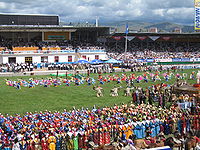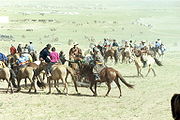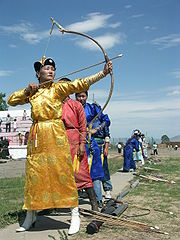
Naadam
Encyclopedia

Mongolia
Mongolia is a landlocked country in East and Central Asia. It is bordered by Russia to the north and China to the south, east and west. Although Mongolia does not share a border with Kazakhstan, its western-most point is only from Kazakhstan's eastern tip. Ulan Bator, the capital and largest...
. The festival is also locally termed "eriin gurvan naadam" "the three games of men". The games are Mongolian wrestling
Mongolian wrestling
Mongolian wrestling, known as Bökh , is the folk wrestling style of Mongols in Mongolia, Inner Mongolia and other regions...
, horse racing
Horse racing
Horse racing is an equestrian sport that has a long history. Archaeological records indicate that horse racing occurred in ancient Babylon, Syria, and Egypt. Both chariot and mounted horse racing were events in the ancient Greek Olympics by 648 BC...
and archery
Archery
Archery is the art, practice, or skill of propelling arrows with the use of a bow, from Latin arcus. Archery has historically been used for hunting and combat; in modern times, however, its main use is that of a recreational activity...
and are held throughout the country during the midsummer holidays. Women have started participating in the archery and girls in the horse-racing games, but not in Mongolian wrestling.
In 2010, Naadam was inscribed on the Representative List of the Intangible Cultural Heritage of Humanity of UNESCO.
Overview
The biggest festival (Naadam of the Country) is held in the Mongolian capital UlaanbaatarUlaanbaatar
Ulan Bator or Ulaanbaatar is the capital and largest city of Mongolia. An independent municipality, the city is not part of any province, and its population as of 2008 is over one million....
during the National Holiday from July 11 – 13, in the National Sports Stadium
National Sports Stadium (Mongolia)
National Sports Stadium is a multi-purpose stadium in Ulaanbaatar, Mongolia. It is currently used mostly for football matches and has a capacity 20,000. The Naadam festival, which celebrates Mongolian independence, is held there every July....
. Other cities and towns across Mongolia and those with significant Mongolian populations in China, have their own, smaller scale Naadam celebrations. It begins with an elaborate introduction ceremony featuring dancers, athletes, horse riders, and musicians. After the ceremony, the competitions begin.
Naadam is the most widely watched festival among Mongols, and is believed to have existed for centuries in one fashion or another. Naadam has its origin in the activities, such as military parades and sporting competitions such as archery, horse riding and wrestling, that followed the celebration of various occasions. Now it formally commemorates the 1921 revolution when Mongolia declared itself a free country.
Another popular Naadam activity is the playing of games using shagai
Shagai
Shagai , chükö , asyk/ashyk/oshuq refers to the astragalus of the ankle of a sheep or goat. The bones are collected and used for traditional games and fortunetelling throughout Central Asia, and games involving the ankle bones may also be referred to by the name of the bones. They may be painted...
, sheep anklebones that serve as game pieces and tokens of both divination
Divination
Divination is the attempt to gain insight into a question or situation by way of an occultic standardized process or ritual...
and friendship. In the larger Nadaam festivals, tournaments may take place in a separate venue.
Wrestling

512 or 1024 wrestlers meet in a single-elimination tournament that lasts nine or ten rounds. Mongolian traditional wrestling is an untimed competition in which wrestlers lose if they touch the ground. When picking pairs, the wrestler with the greatest fame has the privilege to choose his own opponent. Wrestlers wear two-piece costumes consisting of a tight shoulder vest (zodog) and shorts (shuudag). Only men are allowed to play.
Each wrestler has an "encourager" called a zasuul. The zasuul sings a song of praise for the winning wrestler after rounds 3, 5, and 7. Winners of the 7th or 8th stage (depending on whether the competition features 512 or 1024 wrestlers) earn the title of zaan, "elephant". The winner of the 9th or 10th stage, is called arslan, "lion". In the final competition, all the "zasuuls" drop in the wake of each wrestler as they take steps toward each other. Two time arslans are called the champions, or the "avraga".
Horse racing

Children from 5 to 13 are chosen as jockeys who train in the months preceding the races. While jockeys are an important component, the main purpose of the races is to test the skill of the horses.
Before the races begin, the audience sings traditional songs and the jockeys sing a song called Gingo. Prizes are awarded to horses and jockeys. The top five horses in each class earn the title of airgiyn tav and the top three are given gold, silver, and bronze medals. Also the winning jockey is praised with the title of tumny ekh or leader of ten thousand. The horse that finishes last in the Daaga race (two-year-old horses race) is called bayan khodood (meaning "full stomach"). And a song is sung to the Bayan khodood wishing him luck to be next years winners.
See also: Mongol horse
Archery

See also: Mongol bow
Mongol bow
The Mongol bow is a recurved composite bow renowned for its military effectiveness. The old Mongolian bows that were used during the times of Genghis Khan were smaller than the modern weapons used at most Naadam festivals today. Modern Mongolian bows are larger and have string bridges...
See also
- Tsagaan SarTsagaan SarTsagaan Sar , white moon or white month) is the lunisolar New Year festival of the Mongols. Today, Mongols are found in Mongolia, Inner Mongolia, Buryatia and Kalmykia. It is often celebrated around the same time as the Chinese New Year...
(English "White Month"), the Mongolian Lunar New Year (the first most important Mongolian holiday before Naadam).
External links
- Chinggis Khaan's Mongolia. S. Uranbileg and E. Amarbilig. Ulaanbaatar, 2006, 156 p. ISBN 99929-6-508-8. In English.
- Naadam Festival - The Center for the Study of Eurasian Nomads
- Mongolia's Manly Sports - Ron Gluckman
- Naadam Festival Package Tours - Naadam Festival
- Analysis of the three sports of Naadam
- Article about Naadam
- Audio coverage of horse racing

